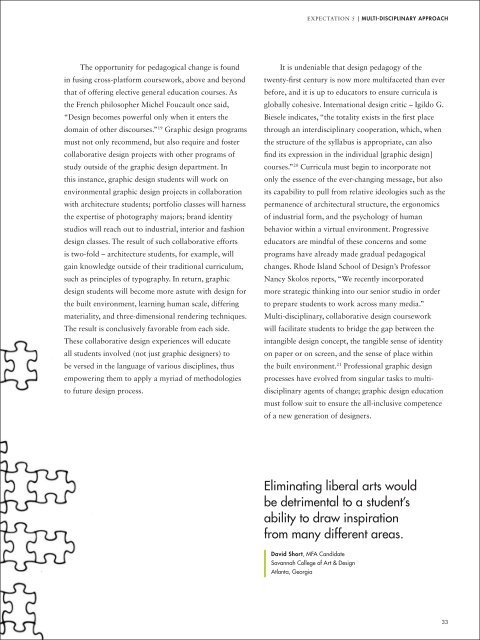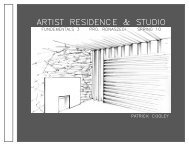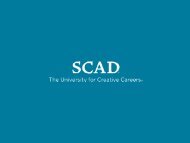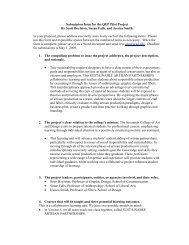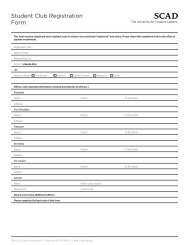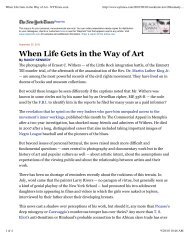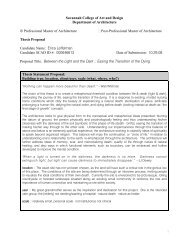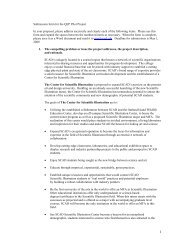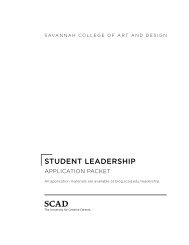Nicole Roberts MFA Thesis Visual Component Artwork - Savannah ...
Nicole Roberts MFA Thesis Visual Component Artwork - Savannah ...
Nicole Roberts MFA Thesis Visual Component Artwork - Savannah ...
You also want an ePaper? Increase the reach of your titles
YUMPU automatically turns print PDFs into web optimized ePapers that Google loves.
EXPECTATION 5 | multi-disciplinary approach<br />
The opportunity for pedagogical change is found<br />
in fusing cross-platform coursework, above and beyond<br />
that of offering elective general education courses. As<br />
the French philosopher Michel Foucault once said,<br />
“Design becomes powerful only when it enters the<br />
domain of other discourses.” 19 Graphic design programs<br />
must not only recommend, but also require and foster<br />
collaborative design projects with other programs of<br />
study outside of the graphic design department. In<br />
this instance, graphic design students will work on<br />
environmental graphic design projects in collaboration<br />
with architecture students; portfolio classes will harness<br />
the expertise of photography majors; brand identity<br />
studios will reach out to industrial, interior and fashion<br />
design classes. The result of such collaborative efforts<br />
is two-fold – architecture students, for example, will<br />
gain knowledge outside of their traditional curriculum,<br />
such as principles of typography. In return, graphic<br />
design students will become more astute with design for<br />
the built environment, learning human scale, differing<br />
materiality, and three-dimensional rendering techniques.<br />
The result is conclusively favorable from each side.<br />
These collaborative design experiences will educate<br />
all students involved (not just graphic designers) to<br />
be versed in the language of various disciplines, thus<br />
empowering them to apply a myriad of methodologies<br />
to future design process.<br />
It is undeniable that design pedagogy of the<br />
twenty-first century is now more multifaceted than ever<br />
before, and it is up to educators to ensure curricula is<br />
globally cohesive. International design critic – Igildo G.<br />
Biesele indicates, “the totality exists in the first place<br />
through an interdisciplinary cooperation, which, when<br />
the structure of the syllabus is appropriate, can also<br />
find its expression in the individual [graphic design]<br />
courses.” 20 Curricula must begin to incorporate not<br />
only the essence of the ever-changing message, but also<br />
its capability to pull from relative ideologies such as the<br />
permanence of architectural structure, the ergonomics<br />
of industrial form, and the psychology of human<br />
behavior within a virtual environment. Progressive<br />
educators are mindful of these concerns and some<br />
programs have already made gradual pedagogical<br />
changes. Rhode Island School of Design’s Professor<br />
Nancy Skolos reports, “We recently incorporated<br />
more strategic thinking into our senior studio in order<br />
to prepare students to work across many media.”<br />
Multi-disciplinary, collaborative design coursework<br />
will facilitate students to bridge the gap between the<br />
intangible design concept, the tangible sense of identity<br />
on paper or on screen, and the sense of place within<br />
the built environment. 21 Professional graphic design<br />
processes have evolved from singular tasks to multidisciplinary<br />
agents of change; graphic design education<br />
must follow suit to ensure the all-inclusive competence<br />
of a new generation of designers.<br />
Eliminating liberal arts would<br />
be detrimental to a student’s<br />
ability to draw inspiration<br />
from many different areas.<br />
David Short, <strong>MFA</strong> Candidate<br />
<strong>Savannah</strong> College of Art & Design<br />
Atlanta, Georgia<br />
33


